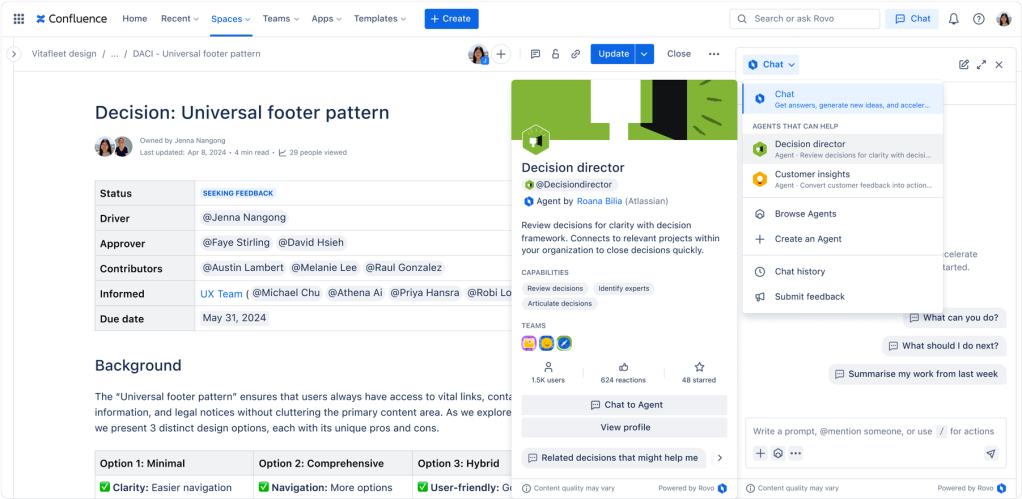Atlassian has developed a new search tool — Atlassian Rovo — that can surface data from a variety of third-party apps. Rovo, currently in preview, provides a chatbot interface to help workers access information across their organization,and even decipher workplace jargon.
“Atlassian Rovo is designed to unlock knowledge discovery and accelerate action across the organization,” said Jamil Valliani, head of product AI at Atlassian. “Think of Rovo as a large knowledge model for your company that allows team members to move and act faster.”
There are three key elements to Rovo: Search, Chat, and Agents.
Rovo Search expands on existing search functions in Atlassian apps, with the ability to access documents from a range of external sources in addition to data held in tools such as Jira and Confluence. This means surfacing information in third-party productivity tools such as Slack, Microsoft Teams, Figma and GitHub, as well as file storage platforms such as Google Drive and Microsoft SharePoint.

Atlassian Rovo can help surface information and answer questions about technical jargon based on access to coporate documents.
Atlassian
Atlassian also plans to let Rovo access data from in-house applications, including finance or HR apps.
One way to access Rovo search is via the search bar in various Atlassian apps. A list of search results containing related documents is presented, as well as more detailed “knowledge cards” that present information relating to a project, for instance, or a team. Here, the knowledge card might contain links to related files, as well as information on project status, listed contributors, and more.
Rovo Search can also learn and explain unfamiliar jargon specific to an industry or individual business based on the organization’s documents. This enables Rovo to provide definitions for acronyms and terms that appear within a Confluence document, for exam-le. It’s proved to be a popular feature, Atlassian said, and is used by three-quarters of staff testing Rovo.
A semantic search function helps teams “connect with what they are looking for,” said Julie Mohr, principal analyst at Forrester, as well as “knowledge they didn’t know existed.” This helps employees “work the way they want to work with a comprehensive set of expressive tools — from video to pages, structured and unstructured, it is all knowledge,” she said.
Another way to search for information is via Rovo Chat. Similar to the conversational interfaces in Microsoft’s Copilot, OpenAI’s ChatGPT, and others, the chatbot responds to user questions in natural language, with answers based on data held in documents across an organization. Links are provided to the original source.

Atlassian Rovo Chat uses genAI and a chatbot interface with natural language processing to deliver information to users.
Atlassian
Another aspect of Rovo that relies on generative AI is the addition of workflow automation “agents.” Accessible via the Rovo Chat sidebar, the Rovo Agents are tailored to a specific task. For instance, Rovo Agents can be designed to generate and review marketing content, collate feedback from various sources, or streamline processes such as clearing up Jira backlogs and organizing Confluence pages.
Users can create their own Rovo Agents using a no-code text interface or Atlassian’s Forge app development platform. Atlassian expects there will be around 20 pre-built agents available when Rovo launches.
Canva’s design software is an example of an Atlassian partner building its own agent. “There’s going to be a Canva agent that helps with generating simple artwork for social media posts, things that you don’t need an expert designer to do,” said Valliani.

Atlassian Rovo agents are tailored to specific tasks and can include agents built by third-party vendors.
Atlassian
“Generative AI has so much potential in knowledge management,” said Mohr. “Atlassian is taking the power of Confluence and improving those capabilities with sound knowledge management practices combined, with new features that take advantage of genAI.”
Making it easier to access information across an organization also means there’s potential for users to access sensitive documents. Atlassian said Rovo will respect permissions around the content it has access to, with restricted data in third-party apps remaining private.
As with any API or integration, businesses should assess risks when connecting to external systems and ensure that adequate permissions are in place around documents, said Mohr. But those risks shouldn’t put businesses off from widening access to information held across their organization, she said.
“[T]hink of all the undiscovered knowledge, all the ideas that are locked up in folders and private stores,” said Mohr. “There is a cultural change that needs to take place, where people as well as the systems understand the value of free access to knowledge.”
Opening employee access to a wider range of information can “empower more collaboration and learning,” said Mohr, with businesses able to restrict access “when it is genuinely needed for regulatory or compliance purposes.”
Atlassian customers can join a waitlist to access Rovo in beta. The general availability date hasn’t yet been announced.
Rovo will be sold as an add-on alongside cloud editions of Atlassian products, with a flexible pricing model based on unique users. More details will be announced at the general availability launch.

